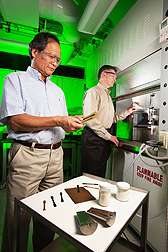Pulp as biodegradable plastic in disposable food containers

U.S. Department of Agriculture (USDA) scientists and university cooperators have developed a biodegradable plastic that could be used in disposable food containers. The plastic, called a thermoplastic, becomes soft when heated.
To make the plastic, Agricultural Research Service (ARS) scientists incorporated biodegradable sugar beet pulp, which is the leftover residue from sugar extraction, with a biodegradable polymer. The result is thermoplastic composites that retain mechanical properties similar to polystyrene and polypropylene, the compounds used to make white, spongy food packages.
Processors generate tons of sugar beet pulp annually. Finding profitable uses for it is critical for the long-term economic viability of U.S. agribusiness. Now, ARS chemist LinShu Liu and plant physiologist Arland Hotchkiss, both at the ARS Eastern Regional Research Center in Wyndmoor, Pa., and their colleagues have found a variety of new uses for sugar beet pulp. ARS is USDA's principal intramural scientific research agency.
In collaboration with professor Jinwen Zhang of Washington State University (WSU) in Pullman, Liu and his colleagues developed the thermoplastic, which is manufactured from both sugar beet pulp and a biodegradable polymer called polylactic acid, or PLA, using a twin screw extruder. PLA is a commercially available polymer derived from the sugars in corn, sugar beet, sugarcane, switchgrass and other plants, all of which are renewable feedstocks. Extrusion is a cost-effective manufacturing process that is popularly used in large-scale production of food, plastics and composite materials.
The researchers showed that up to 50 percent sugar beet pulp can be incorporated with PLA to produce biodegradable thermoplastic composites that are similar to the petrochemical compounds used in making spongy disposable food packages. The new thermoplastic is cost-competitive with such commonly used petrochemical plastics, according to the scientists.
A study describing the work was published in Industrial & Engineering Chemistry Research.
More information: Read more about this research in the January 2013 issue of Agricultural Research magazine.
Journal information: Industrial & Engineering Chemistry Research , Agricultural Research
Provided by Agricultural Research Service
















